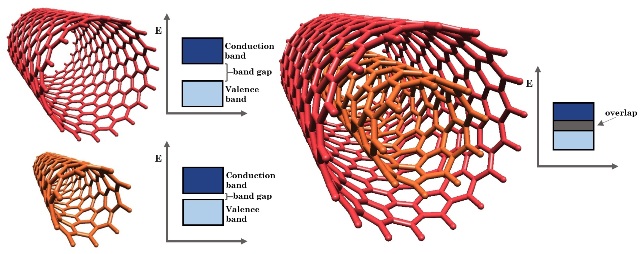Double-walled carbon nanotubes can be tuned for specific electronic properties
April 17, 2015

Tuning electronic properties: individual single carbon nanotubes (left) have band gaps (energy levels) and are semiconductors, but when combined (right), the band gaps overlap and make the double-walled structure a semimetal (credit: Matías Soto/Rice University)
Using atomic-level models of double-walled carbon nanotubes, Rice University scientists have found that it may someday be possible to tune double-walled tubes for specific electronic properties by controlling their configuration, chiral angles, and distance between walls.
The open-access research reported in Nanotechnology was chosen as the journal’s “publisher’s pick” this month. The journal also published an interview with the study’s lead author, Rice graduate student Matías Soto.
Carbon nanotubes, grown by various methods, come in two basic varieties: single-walled and multiwalled (two or more walls). The researchers found that the distance between the walls — as small as a fraction of a nanometer difference — and the individual chirality (differences in symmetry between the angles of their hexagonal arrangement of atoms) of the tubes impact the double-walls’ electrical properties.
The researchers also found the diameter of the tube — especially the inner one, with its more pronounced curvature — has a small but significant impact on the structure’s semiconducting properties.
Possible path to nanotube transistors
Most importantly, they found that semiconducting nanotubes wrapped around metallic, highly conductive nanotubes could be the best candidates for tuning the band gap, the property that defines the value of a semiconductor.
“The most interesting thing we found was that when you combine a metallic with a semiconductor, the band gap depends on the distance between them,” Soto said, and that adjusting the distance could lead to nanotube transistors.
Other nanotube configurations may be best for turning into macroscopic carbon nanotube conducting wires, particularly with metallic-metallic nanotubes, the researchers found.
The Department of Energy’s Research Partnership to Secure Energy for America, the Mexican government’s CONACyT program and the state of Nuevo León funded the research. The researchers used the National Science Foundation-supported DAVinCI supercomputer administered by Rice’s Ken Kennedy Institute for Information Technology.
Abstract of Effect of interwall interaction on the electronic structure of double-walled carbon nanotubes
Through this study, the results of density functional theory calculations within the local density approximation of the electronic structure of zigzag–zigzag double-walled carbon nanotubes (DWCNTs), with chiral indices (n, 0)@(m, 0) for n = 7–15, andm = 15–26, has been presented and the effects of interwall interaction and orbital hybridization on the electronic structure of these systems has been discussed. It was observed that the electronic band gap of the aforementioned DWCNTs depends on the interwall distance only for metallic–semiconductor configurations and on the intrinsic properties of the constituent tubes in all other combinations. It was also observed that the calculated band gap for most of the metallic–metallic DWCNTs was smaller than semiconductor–metallic, metallic–semiconductor, and semiconductor–semiconductor configurations. Metallic–semiconductor DWCNTs were found to be desirable for band gap tuning applications because of their dependence on interwall distance, opening up the possibility of using such systems in electronic device applications, such as transistors. Other applications include the use of DWCNTs in macroscopic carbon nanotube conducting wires, for which metallic–metallic and semiconducting–metallic zigzag–zigzag DWCNTs were found to be the most desirable configurations due to their small band gaps.